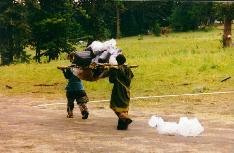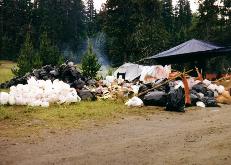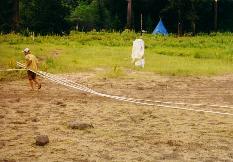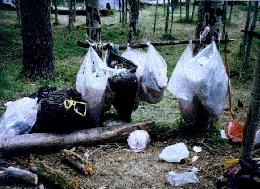 These two
brothers are helping carry out more than than what they brought
in. Note how the plastic, etc.. is already sorted.
These two
brothers are helping carry out more than than what they brought
in. Note how the plastic, etc.. is already sorted.
Start with disappearing a fire, if there is one. I personally only cook on a backpacking stove by my tent, and I usually eat at one of kitchens anyway. First make sure the fire is good and out. Spread the rocks throughout the local area, with the sotty sides down. Fill in the hole with dirt and small rocks. Cover the dirt with pine needles, sticks, moss, whatever is appropriate for that spot. You can make make this easier by preserving the brush and topsoil when you make your fire pit. Don't forget to preserve the soil for the several weeks you may be at the gathering, you should pile it and/or cover it with a tarp, otherwise it'll get compacted or wash away before you can use it to restore the site.
Brush up flattened grass where the tent or tarp was. Brush up the dirt, and spread needles, sticks, etc... to make the site look as undisturbed as possible. Do the same to any trails that you've made while in camp. Soil compactation is the number one impact of any persons presence.
 The piles are sorted
into burnables, glass, metal, plastic, etc. As little as possible is
taken to a landfill.
The piles are sorted
into burnables, glass, metal, plastic, etc. As little as possible is
taken to a landfill.In some years, like at the North Carolina Rainbow Gathering, the Forest Service took videos of the recycling piles, and have since used this video in many court cases since, claiming it is the trash left onsite. They forget to mention that the reason the recycling piles were still there, was because they had arrestd the cleanup crew for exceeding the 14 day camping rule. Obviously a manufactured incident. We know that all good Rainbows never leave trash behind.
Look good at this picture too, cause this is where everything winds up that anyone doesn't carry out. If you leave any trash behind, here is where it winds up. Then after sorting through this mess to produce nicely organized piles, it has to be driven to the recycling center, or the landfill, both of which cost money, which is usually in short supply.
 These two
brothers are helping carry out more than than what they brought
in. Note how the plastic, etc.. is already sorted.
These two
brothers are helping carry out more than than what they brought
in. Note how the plastic, etc.. is already sorted.
 Several miles of PVC water pipe is used to help supply clean water to
the gathering. The water comes from springs that are tapped, and the
water is distributed by gravity feed.
Several miles of PVC water pipe is used to help supply clean water to
the gathering. The water comes from springs that are tapped, and the
water is distributed by gravity feed.
 This is a good example of a camp's own recycling station. Any sorting
and recycling done by each camp and kitchen makes less work for the
folks that stay for cleanup. Cleaning up ones own camp to where there
is no more cleanup and restoration is the Rainbow ideal.
This is a good example of a camp's own recycling station. Any sorting
and recycling done by each camp and kitchen makes less work for the
folks that stay for cleanup. Cleaning up ones own camp to where there
is no more cleanup and restoration is the Rainbow ideal.